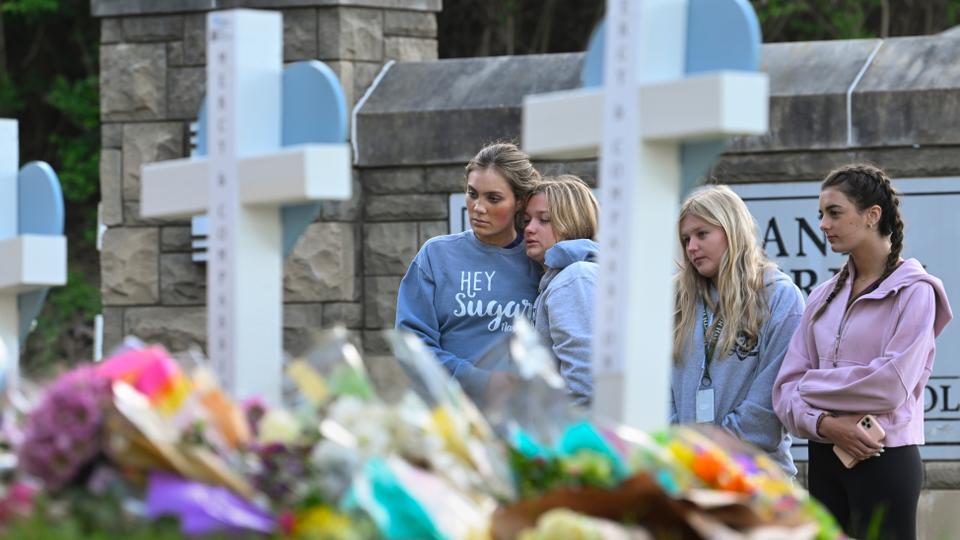Mass killings are happening with staggering frequency this year: an average of once every 6.53 days.
The US is setting a record pace for mass killings in 2023, replaying the horror on a loop roughly once a week so far this year.
The carnage has taken 88 lives in 17 mass killings over 111 days.
Each time, the killers wielded firearms. Only 2009 was marked by as many such tragedies in the same period of time.
Children at a Nashville grade school, gunned down on an ordinary Monday.
Farmworkers in Northern California, sprayed with bullets over a workplace grudge.
In just the last week, four partygoers were slain and 32 injured in Dadeville, Alabama, when bullets rained down on a Sweet 16 celebration.
And a man just released from prison fatally shot four people, including his parents, in Bowdoin, Maine, before opening fire on motorists traveling a busy interstate highway.
“Nobody should be shocked,” said Fred Guttenberg, whose 14-year-old daughter, Jaime, was one of 17 people killed at a Parkland, Florida, high school in 2018.
“I visit my daughter in a cemetery. Outrage doesn’t begin to describe how I feel.”
The Parkland victims are among the 2,842 people who have died in mass killings in the US since 2006, according to a database maintained by The Associated Press and USA Today, in partnership with Northeastern University.
The bloodshed represents just a fraction of the fatal violence that occurs in the US annually.
Yet mass killings are happening with staggering frequency this year: an average of once every 6.53 days, according to an analysis of The AP/USA Today data.
Devastating numbers
The 2023 numbers stand out even more when they are compared to the tally for full-year totals since data was collected.
From coast to coast, the violence is sparked by a range of motives.
Murder-suicides and domestic violence; gang retaliation; school shootings and workplace vendettas.
All have taken the lives of four or more people at once since January 1.
The pace of mass shootings so far this year doesn't necessarily foretell a new annual record.
In 2009, the bloodshed slowed and the year finished with a final count of 32 mass killings and 172 fatalities.
Those figures just barely exceed the averages of 31.1 mass killings and 162 victims a year, according to an analysis of data dating back to 2006.
Gruesome records have been set within the last decade. The data shows a high of 45 mass killings in 2019 and 230 people slain in such tragedies in 2017.
“Here’s the reality: If somebody is determined to commit mass violence, they’re going to,” said Jaclyn Schildkraut, executive director of the Rockefeller Institute of Government’s Regional Gun Violence Research Consortium. “And it’s our role as society to try and put up obstacles and barriers to make that more difficult.”
But there’s little indication at either the state or federal level — with a handful of exceptions — that many major policy changes are on the horizon.
State, federal action
Some states have tried to impose more gun control within their own borders.
Last week, Michigan Governor Gretchen Whitmer signed a new law mandating criminal background checks to purchase rifles and shotguns, whereas the state previously required them only for people buying pistols.
And on Wednesday, a ban on dozens of types of semi-automatic rifles cleared the Washington state Legislature and is headed to the governor’s desk.
In conservative Tennessee, protesters descended on the state Capitol to demand more gun regulation after six people were killed at the Nashville private elementary school last month.
At the federal level, President Joe Biden last year signed a milestone gun violence bill, toughening background checks for the youngest gun buyers, keeping firearms from more domestic violence offenders and helping states use red flag laws that enable police to ask courts to take guns from people who show signs they could turn violent.
Still, experts and advocates decry the proliferation of guns in the US in recent years, including record sales during the first year of the Covid-19 pandemic.
“We have to know that this isn’t the way to live,” said John Feinblatt, president of Everytown for Gun Safety.
“We don’t have to live this way. And we cannot live in a country with an agenda of guns everywhere, every place and every time.”
